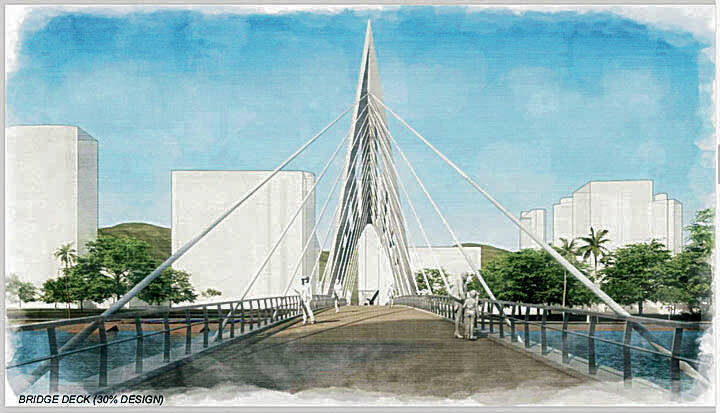Column: Ala Wai bridge would be an asset

COURTESY PHOTO
A rendering shows the proposed Ala Wai bridge.
Arguments against the proposed Ala Wai bridge are antipoor, anti-equity, and not grounded in democracy or reality.
While the line received much applause at a recent meeting, saying the funds for the proposed Ala Wai bridge should go to Lahaina are not grounded in democracy or reality. It is antidemocratic because federal funds come through a democratic legislative process. Returning federal funds and reallocating them would require approval by a congressional committee and both chambers of Congress. The reality is that returning transportation project funds to the federal government to be reallocated for a disaster relief agency, would not guarantee those funds would return to Hawaii. In all likelihood they would go elsewhere. As a society based on the rule of law, a federal legislator cannot simply tell his colleagues to reallocate funds.
Some argue that one recent meeting should override the 10 community meetings held prior, which is also antidemocratic.
Saying the project is unnecessary is antipoor and anti-equity. About 17% of Oahu households do not own cars, nearly 70% of those households are low-income. Both current crossings from Moiliili to Waikiki, McCully Street and Kapahulu Avenue are riddled with problems. They are plagued with too-narrow crosswalks, that a person in a wheelchair would have issues fitting through, and bike lanes that either disappear at random points or are nonexistent. People who do not own cars, especially those who are low-income, deserve safe, convenient crossings. This includes children, among which traffic violence is still the leading cause of death.
Stating that the proposed Ala Wai bridge will encourage crime is antipoor and not based on reality. This argument assumes that people who walk or bike, who are more likely to be low-income, commit more crimes. Honolulu police issue more than 400,000 traffic violation citations annually, all of which are crimes, and spend about 79% of their time issuing these. Police, who are the experts on crime prevention, support projects like the Ala Wai crossing, as more foot traffic in an area is a deterrence to crime. Police officers, present and retired, have testified in support of the project.
There is already a pedestrian-bicycle bridge connecting two neighborhoods: Chinatown and Kalihi-Palama. This bridge is located on Nuuanu River, located between Beretania Street and Kukui Street. This bridge is free of criminal activity, and offers a safe and convenient crossing for those who walk and bike. The proposed Ala Wai bridge would do the same.
Don't miss out on what's happening!
Stay in touch with breaking news, as it happens, conveniently in your email inbox. It's FREE!
Saying the proposed Ala Wai bridge would block the views of Diamond Head is not grounded in reality. The proposed bridge is mauka to makai. The makai side, Waikiki, has many tall buildings, many of which are taller than the proposed bridge. The proposed bridge is arguably more Native Hawaiian-looking compared to the many buildings in Waikiki. As a kamaaina, I support city and state efforts to honor our host culture.
Beyond making it safer and more equitable for those who walk and bicycle, the proposed Ala Wai bridge provides a faster emergency route in the event of an emergency, flooding, tsunami or otherwise. While the mauka side of the proposed bridge is still in a flood zone, it would provide faster access for those who live or play toward the center of Waikiki, eventually going past Moiliili and out of harm’s way.
The city should support all projects that encourage everyone to “move naturally,” increasing safety on the streets and neighborhoods. The proposed Ala Wai bridge is a great step toward doing this.
Anthony Chang is a transportation and land-use planner who also owns a small business that has mainly operated out of Waikiki and Moiliili.



